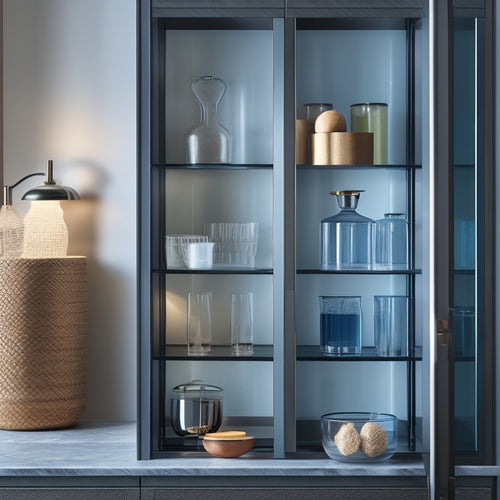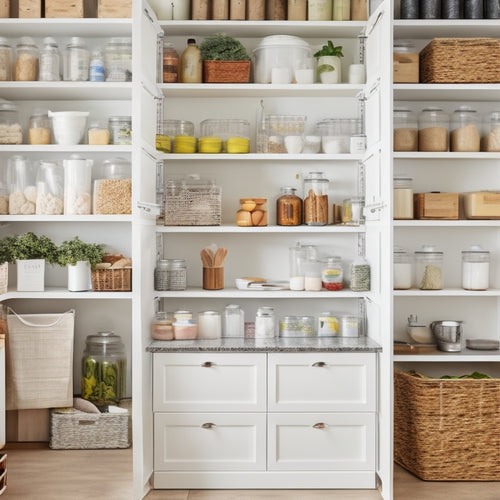
How to Create a Recessed Shower in a Wall
Share
You'll need to plan carefully when creating a recessed shower in a wall, evaluating available space and identifying potential obstacles like ventilation ducts or wall studs. Prepare the wall by inspecting for water damage, cracks, or weaknesses, and install a moisture barrier to prevent water damage behind the shower. Cut and remove drywall, then install the shower pan and drain, ensuring a level subfloor and following manufacturer's instructions. Next, build the shower niche structure, applying a moisture barrier and waterproof sealants to prevent water intrusion. With these steps complete, you're ready to move forward with the installation process.
Key Takeaways
- Assess existing plumbing and electrical infrastructure to ensure compatibility with the recessed shower design.
- Prepare the wall by inspecting for damage, installing a moisture barrier, and cutting out the drywall to create a clear path.
- Install a shower pan and drain, selecting a compatible drain type and following the manufacturer's instructions for a leak-free installation.
- Build the shower niche structure using durable, water-resistant materials, ensuring a snug fit and proper fastening to surrounding studs.
- Waterproof the shower area by applying a moisture barrier, sealing gaps and joints, and using waterproof sealants to prevent water damage and mold growth.
Planning the Recessed Shower Space
When designing a recessed shower space, your bathroom's existing plumbing and electrical infrastructure become key considerations. You'll need to determine where the water supply lines, drainage pipes, and electrical outlets are located to guarantee your shower design doesn't conflict with them.
Take note of any obstacles, such as ventilation ducts or wall studs, that might impact your space optimization.
Next, assess the available space and decide on the shower's dimensions. Consider the size and shape of the showerhead, body sprays, and any other features you want to include.
Don't forget to factor in the thickness of the shower walls, floor, and ceiling when calculating the overall space requirements.
To optimize the space, think vertically – recessed shelves or niches can provide storage without sacrificing floor space.
Also, consider a curbless design to create a seamless shift between the shower and the rest of the bathroom.
Preparing the Wall for Installation
Your recessed shower's success hinges on a solid foundation, and that begins with a properly prepared wall. Before you start cutting into the drywall, take a step back and assess the wall type you're working with. Is it a standard 2x4 construction or a 2x6? Maybe it's an exterior wall with insulation and a weather-resistant barrier.
Whatever the case, it's essential to identify the wall's components to guarantee a successful installation.
Next, inspect the wall for any signs of water damage, cracks, or weaknesses. You don't want to create a recessed shower only to have it compromised by a pre-existing issue.
Take note of any electrical outlets, plumbing fixtures, or other obstacles that might affect your installation.
Now it's time to prepare the wall for the recessed shower. This involves installing a moisture barrier to prevent water from seeping behind the shower and causing damage.
You can use a waterproof membrane or a specialized shower pan membrane, depending on your shower design and local building codes.
With a solid wall preparation, you'll be ready to move on to the next step: cutting and removing the drywall.
Cutting and Removing Drywall
Across the area where you'll install the recessed shower, mark a rectangular outline on the wall, using a level to make certain it's straight and a pencil to create a clear boundary. This outline will guide your drywall cutting and removal process.
Next, gather your drywall tools, including a drywall saw or utility knife, a dust mask, and safety goggles. Before you start cutting, take necessary safety precautions to avoid inhaling drywall dust and debris. Wear your dust mask and safety goggles to protect yourself from the mess.
Using your drywall saw or utility knife, carefully cut along the marked outline, applying gentle pressure to avoid damaging surrounding drywall.
Continue cutting until you've removed the entire section of drywall within the marked area. Remove the cut drywall pieces, taking care not to scratch the surrounding wall surface.
With the drywall removed, you'll have a clear path to the next step in creating your recessed shower.
Installing the Shower Pan and Drain
The shower pan and drain form the foundation of your recessed shower, and their proper installation is crucial for a leak-free and functional shower.
You've got two main options for shower pans: prefabricated or custom. Prefabricated pans come in standard sizes and are generally easier to install, while custom pans offer more flexibility regarding size and shape. Whichever type you choose, make certain it's specifically designed for recessed showers.
When it comes to drain types, you've got three main options: linear, point, and channel. Linear drains are sleek and modern, while point drains are more traditional. Channel drains are a good choice if you want a more minimalist look. Regardless of which type you choose, make certain it's compatible with your shower pan.
Before installing the shower pan and drain, verify the subfloor is level and clean.
Then, follow the manufacturer's instructions for installation. Don't skip this step – a poorly installed shower pan and drain can lead to leaks, water damage, and a whole lot of headaches.
Take your time, and get it right the first time.
Building the Shower Niche Structure
Now that the shower pan and drain are in place, you can start building the shower niche structure. This is where your niche design comes to life, so get excited!
You'll need to decide on the material selection for the structure, considering factors like durability, water resistance, and aesthetics. Common choices include cement backer board, PVC, or even glass fiber-reinforced concrete.
Cut the material to size, guaranteeing a snug fit within the shower wall. Use a level to verify the structure is plumb and level, as any deviations will be noticeable once the niche is finished. Fasten the material to the surrounding studs using appropriate fasteners, such as screws or anchors.
Next, create the niche's interior shape by cutting and fitting the material to form the desired design. You can use a jigsaw or a reciprocating saw for curved cuts, or a circular saw for straight cuts.
Don't forget to leave space for any necessary plumbing or electrical components. With the structure built, you're one step closer to a stunning recessed shower niche that's both functional and visually appealing.
Waterproofing the Shower Area
During the shower's construction, waterproofing the shower area is a critical step that secures the longevity and functionality of your recessed shower niche. You can't afford to skip this step, or you'll be dealing with water damage and mold growth in no time.
To get it right, start by applying a moisture barrier to the entire shower area, including the walls, floor, and ceiling. This barrier will prevent water from seeping behind the tile and causing chaos. Be certain to follow the manufacturer's instructions and apply the barrier correctly to guarantee its effectiveness.
Next, focus on surface sealing. This involves sealing all the gaps and joints in the shower area, including the ones around the niche, drain, and any other penetrations.
Use a waterproof sealant, such as silicone or polyurethane, to fill these gaps and create a watertight seal. Remember, a little extra effort here will save you from a world of trouble down the line.
Finishing the Shower With Tile
You're now ready to finish your recessed shower with tile, which requires careful planning and execution.
You'll need to select a tile pattern that suits your shower's design and prepare your walls using a method that guarantees a secure bond between the tile and the wall.
Next, you'll apply grout to fill the gaps between the tiles, using a technique that minimizes mess and guarantees a professional-looking finish.
Tile Pattern Selection
Selecting the right tile pattern is an essential step in finishing your recessed shower, as it not only adds visual appeal but also affects the overall functionality of the space. You want to choose a pattern that complements your modern design while also creating a sense of continuity with the rest of the bathroom.
When it comes to tile pattern selection, there are a few factors to evaluate. Here's a breakdown of some popular options:
| Pattern | Description |
|---|---|
| Linear | Simple, clean lines that create a sense of continuity |
| Herringbone | A classic, zig-zag pattern that adds visual interest |
| Brick | A timeless, rectangular pattern that works well with accent tiles |
Wall Preparation Method
Most recessed showers require a solid, waterproof substrate to guarantee a successful tile installation.
You'll need to prepare your wall to ascertain a watertight seal and a smooth tile application. Start by inspecting the wall for any cracks or damage, and repair them with a patching compound.
Next, focus on selecting the right tools for the job. You'll need a notched trowel, a level, and a rubber float to ascertain even adhesive application and to remove excess grout.
To prepare the wall, follow these essential steps:
- Apply a moisture barrier to the entire area, ensuring it's fully adhered and wrinkle-free.
- Install a waterproof backer board, such as cement board or fiber-reinforced board, to provide a solid base for your tile.
- Check the wall's levelness and plumbness, making any necessary adjustments.
- Clean the surface thoroughly to remove dirt, dust, or old adhesive.
- Apply a bonding agent to the backer board, if recommended by the manufacturer.
Grout Application Technique
With the wall preparation complete, the focus shifts to grout application, a critical step in finishing the shower with tile. You're about to fill those gaps between tiles with a substance that's both functional and aesthetically pleasing.
Choose the right grout type for your shower. Sanded grout is ideal for larger gaps (1/8 inch or more), while unsanded grout is better suited for smaller gaps. Epoxy-based grout offers superior durability and stain resistance, but it's more challenging to work with.
Select a grout color that complements your tile. You can choose a matching color to create a seamless look or a contrasting color to accentuate the tile pattern. Always read the instructions and follow the manufacturer's recommendations for mixing and application.
Apply grout using a grout float, pressing it firmly into the gaps. Remove excess grout with a damp sponge, changing the water frequently to avoid re-depositing grout onto the tile.
Allow the grout to set according to the manufacturer's instructions before sealing. Remember, proper grout application is key to a waterproof and visually appealing shower.
Frequently Asked Questions
Can I Install a Recessed Shower in an Exterior Wall?
You're wondering if you can install a recessed shower in an exterior wall? Well, technically yes, but consider the exterior wall considerations, like insulation and waterproofing, to reap the recessed shower benefits, like more space and a sleek look.
How Do I Ensure the Shower Pan Is Level?
Don't let your shower dreams go down the drain! You're wise to worry about a level shower pan. Choose materials like acrylic or PVC, and consider drainage considerations like a pre-sloped pan or linear drain to guarantee water flows freely.
Are Recessed Showers Suitable for Small Bathrooms?
You're wondering if recessed showers are suitable for small bathrooms, and the answer is yes! They're perfect for space optimization, as they don't protrude into the room, and their sleek design aesthetics will make your tiny bathroom feel more spacious and stylish.
Can I Use a Pre-Fabricated Shower Niche?
You can use a pre-fabricated shower niche, but don't settle for bland - investigate various shower niche types, like recessed, corner, or decorative, and follow niche installation tips to guarantee a watertight seal and stylish integration.
Do I Need a Permit to Create a Recessed Shower?
You're about to release a torrent of waterworks wonder, but first, check if your local authorities require a permit for shower plumbing and wall insulation modifications - don't get caught in a regulatory downpour!
Conclusion
You've successfully created a recessed shower in a wall! Remember, "measure twice, cut once" - a mantra that holds true for this project. With careful planning, precise execution, and attention to detail, your new shower space is now ready for tile installation. Take satisfaction in your handiwork, knowing that a job well done will guarantee a leak-free and enjoyable showering experience for years to come.
Related Posts
-

Space-Efficient Glass Door Cabinet Solutions
Looking for space-efficient glass door cabinet solutions? You're in for a treat! These stylish cabinets maximize your...
-

RADICAL HEALTH REVOLUTION: Blueprint for Eternal Wellness
I've spent years feeling stuck, searching for a way to break free from mediocre health and access a life of vibrancy ...
-

Get Organized: Free Pantry Labels + More
I've learned the hard way that organization comes before labeling - a cluttered pantry with labels can actually look ...


